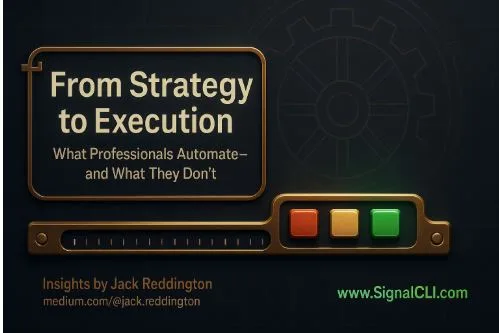From Strategy to Execution: What Professional Traders Automate—and What They Don’t
Why professionals use signals differently than beginners
There’s a common misconception that automated trading tools exist to replace human strategy. In reality, the best traders use automation not to think for them — but to trade faster and cleaner. They don’t outsource their judgment. They outsource the repetitive, mechanical parts of decision-making so they can focus on what automation can’t capture: bigger market context, policy news, trend breaks, and how to allocate capital effectively.
In short, they automate execution — not judgment.
What gets automated (and why)
A well-structured signals platform doesn’t guess or improvise. It processes data — combining indicators, order flow, historical patterns, and adaptive filters — to surface direction-only signals. These signals are issued with timestamps, tied to published schedule windows, and graded by historical performance with tools like Zones and Gradients.
This means the trader doesn’t have to monitor a dozen charts or rerun indicators constantly. The platform does the heavy lifting, so execution becomes a structured yes/no decision: Is this signal in my approved session and context? If yes, act with discipline. If not, pass.
The result: fewer fatigue trades, less emotional overtrading, and less wasted time re-checking the same setups.
What stays manual (on purpose)
Professional traders don’t automate trend awareness. They still analyze the macro bias, interpret recent headlines, track regulatory changes, and study long-term structure. They monitor volatility conditions, token unlocks, exchange listings, and even whale activity.
The reason is simple: no algorithm can fully capture a Black Swan or policy shock. Even when signals call direction correctly, context determines how much to size and how aggressively to hold.
Signals cut noise. Human traders supply context.
The trading flow professionals rely on
Professionals don’t stay glued to screens all day. They define a daily session usually overlapping with liquidity peaks and correlated those to published Green Zones — and structure their work around a routine:
- Pre-session: Review macro headlines, check for catalysts, and decide if trading with or against trend. Adjust size plans if volatility is elevated.
- At session start: Open the signals feed. Confirm the current Zone grade and Gradient. If it’s Green and strong, proceed. If not, reduce size or skip.
- Decision: Act only on signals that pass the checklist. Direction matches context? No news conflicts? Is volatility manageable? Then execute small, with clear risk limits.
- Exit & log: Take clean exits. If a move stalls, partial out. Log time, signal quality, and Gradient rating. Over time, this builds a dataset that strengthens decision-making.
How this changes performance
With automation handling detection and filtering, the trader’s role sharpens: choose when to engage and decide how to size risk. Professionals often trade less, but with better quality. They skip more signals, hold fewer positions, and make more calculated choices. Fees decline, errors decline, emotional tilt declines. What improves is consistency.
This doesn’t guarantee profit. But it guarantees discipline.
Why structure travels well
Professionals who move across firms or regions carry the same process with them. That’s the value of structured execution. Whether trading from Singapore, Berlin, or Sydney, the framework remains: verified signals, published schedule windows, and consistent Zone grading.
This portability matters. Tools may change, brokers may change, even asset classes may change. But the routine holds. The goal isn’t full automation — it’s about reducing low-value decisions, minimizing noise, and focusing attention on what matters: context, risk, and judgment.
Structure protects attention. And attention is the rarest resource in fast markets.
How structure compounds over time
Each well-timed, well-sized, well-documented trade adds to your edge. Over months, these habits generate statistical momentum. The essentials: trade only inside published windows, adjust size by Zone and Gradient, and keep detailed logs. That’s how you separate what works from what doesn’t.
Structure won’t predict the future. But it cuts clutter, reduces fatigue, and frees you to focus on higher-value analysis. Traders who operate with structured routines don’t just move faster—they move smarter.
Lessons from the field
Seasoned traders often share the same story: their results improved the moment they stopped trying to watch every tick and started working only inside structured windows. Logs showed lower fee drag. Sessions became calmer. Fewer trades were placed, but win rates improved because quality was higher. What looked like “doing less” turned into steadier outcomes.
Another recurring theme: using logs to refine size. Professionals don’t rely on gut feel; they check which Zones historically delivered their best results, then scale exposure accordingly. This transforms anecdotal memory into hard evidence.
Key takeaways for 2025
- Automate execution, not judgment. Use signals to handle detection and timing; keep trend and news interpretation human.
- Define trading windows. Work inside published schedules and Green Zones; skip the rest.
- Size by conditions. Use Zone grading and Gradients to adjust risk, not gut feel.
- Log outcomes. Data-driven review compounds discipline and reveals edge.
- Stay adaptable. Structure scales across markets, firms, and geographies.
Why this matters in 2025
As crypto futures markets mature, traders face thinner edges and heavier competition. Speed alone is not enough. Discipline, structure, and clarity are what separate professionals from noise. Automation helps cut the clutter, but judgment remains human. The firms and individuals who balance the two are positioned to thrive.
About SignalCLI
SignalCLI is a crypto futures signals provider focused on clarity, precision, and informed decision-making. Using a combination of established technical indicators, Smart Money Concepts, and advanced AI analysis, SignalCLI delivers structured, data-driven insights to help traders identify high-probability setups in fast-moving markets. The service is designed for those who value disciplined execution, risk awareness, and timing over speculation. For deeper insights and practical examples, visit www.signalcli.com and explore Jack Reddington’s Medium for trading strategies, market breakdowns, and educational articles.






